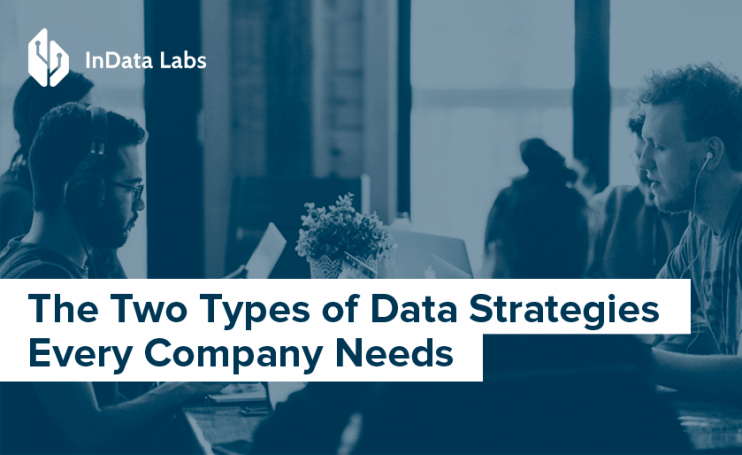The volume of information that exists in the world is growing exponentially, where almost 90% of it was created in the last two years. And as the volume of information increases, so does the pressing need for a good data strategy.
Many have been avid advocates of a coherent strategy for organizing, governing, analyzing, and deploying an organization’s information assets. But it hasn’t been easy.
More often than not, businesses become overwhelmed with the amount of their data and put it lowest on the priority list. However, a proper data strategy can be the driving factor behind increased revenue, gained market share, and higher customer satisfaction.
Let’s dive into how a proper data strategy for small businesses and big enterprises alike should look like.
What Is a Data Strategy
A data strategy is a vision for how a company will collect, store, manage, share, and use information. This strategy should be tightly connected to business goals, and help an organization achieve them. Share on XWhatever business objective you hope to achieve with your data business strategy it is likely to fall into one of the two types of data strategies: defense or offense.
What Is a Defense Strategy
A defense strategy is about minimizing downside risk. As the name somewhat suggests, these are activities that protect your business. This can be:
- Making sure your business complies with rules and regulations.
- Utilize data to detect and eliminate vulnerabilities in the system.
- Develop anti-theft systems.
Another side of defense strategies is ensuring information integrity. This relates to gathering, standardizing, and governing important data, such as customer and supplier information in one data storage. This is often referred to as “a single source of truth.”
Defense strategies are often supported by different metrics. For example, for the operational side of the business, you might reference metrics such as website performance, marketing budget usage, and email opening rates. These will help you uncover some potential operational efficiencies. On the other hand, getting deeper analytical insight requires the use of metrics such as customer acquisition cost, content effectiveness, and share of voice.
Looking at these metrics you might better understand why ensuring information integrity is an important part of any defense strategy. For example, if the marketing team is calculating a different number for customer acquisition cost than the sales department, it will affect their respective strategies going forward.
What Is an Offense Strategy
While a defense strategy focuses on protecting your business, an offense strategy is meant to grow your business. It focuses on increasing revenue, profitability, and customer satisfaction through the smart use of information and data analytics. The goal is to support key managerial decisions.
Offensive strategies tend to be more suited for customer-facing departments, such as sales and marketing. These departments deal more often with more real-time data, which needs to be reflected in your data driven business strategy. For example, real-time data can be harder to validate and process.

Source: Unsplash
Offensive strategies also allow users to go deeper into their data and understand not only what information they have, but where it came from and how much trust they can put behind it. This is, according to Gartner, one of the biggest challenges in today’s business world. Because of that, this is where artificial intelligence consulting agencies are often involved as it’s a complicated and time consuming process.
Finding the Balance between Both Strategies
At this point, it’s natural to ask yourself the question: “what should I choose – offense or defense data strategy? The answer to that question is not a straightforward “yes” or “no”.
Every company needs both an offense and a defense strategy to succeed. The trick is getting the right balance, and many companies do tend to lean more towards one or the other.
Your industry will shape a lot of your organization’s data strategy. Companies that operate in heavily regulated fields will need to focus on defensive strategies. Lack of compliance or security breaches tend to be more expensive and more damaging to brand reputation in those types of industries. Two good examples of that are the healthcare and financial industries.

Source: Unsplash
Companies that operate in ultra-competitive industries, on the other hand, need to focus more on offense strategies. The competitive business landscape demands a constant influx of customers, capture of new markets, rapid releases of new products, etc. The margins for error in the competitive industries are small, and companies need to rely on the smart use of information to drive all these decisions.
For such companies where data and analytics go hand in hand, a natural thing is to invest in data science. In fact, many industries having a data science initiative has gone from being a competitive advantage to a prerequisite.
The last aspect to think about its resources. Each company has a finite amount of funding and people. Your organization needs to consider the top priorities when it comes to the data you have and distribute the resources accordingly. Chances are, there will be many compromises that will need to be made.
Resource scarcity is especially important to think about when considering the investment in data science and machine learning. Some companies might afford to gather an in-house team of analysts and data scientists, while others should consider data science consulting.
Essential Building Blocks of any Data Driven Strategy
Now that you’ve learned about the fundamental aspects of big data and business strategy, let’s discuss how to build a data strategy for a company.
Regardless of what type of data strategy that dominates your company, there are some fundamental principles that every company should try to uphold. These principles will make the execution of your big data business strategy much more efficient and simpler.
Remember that most of these principles are connected, and one cannot be upheld without involving one of a few others.

Source: Unsplash
Eliminate Information Silos
This principle is very much in line with the “single source of truth” philosophy of the defensive strategy. Ultimately, all enterprise data should be organized in one system (or a few at most) that is accessible to the whole organization.
That doesn’t mean that you should forgo things like security clearances and provide all information to all levels of employees. The main goal is to prevent valuable information from getting stuck on selected computers or systems.
Streamline Data Collection Methods
Good data quality is important for each company. To upkeep that, it’s important to establish consistent processes for collecting and sharing data. This entails everything from standardizing spelling and formatting to laying down rules for what type of information is worth collecting. Another important part of all types of data collection strategies developing well-organized ways of cataloging information for easy future reference.
Don’t Make Strategies, Make Goals
As we already mentioned earlier, your data driven strategy will be tightly tied to your business goals. This doesn’t only mean overarching goals like maintaining customer satisfaction or having YoY revenue growth of 5%. This also includes short term goals.
These are likely to come from your bigger, overarching goals, and they can help your organization track how effective your strategy is. Each short-term goal can also be connected to different parts of your business data strategy, for example, storage, sharing, or collection.
Make the Data Easy to Use
In addition to making sure that information silos are eliminated, it is important that information can be accessed easily. This means two things:
- Systems that are easy to use and eliminate the need to make copies of the data (this can contribute to silos).
- Data is stored in a usable format.
Data has no value if it’s raw, i.e. stored in different formats, such as text, spreadsheets, emails, etc. All data needs to be transformed, corrected, or formatted consistently. This will make it easier to use for analytics purposes later on.
Establish Clear Rules for How Data Should be Managed
As we’ve already established before, the true value of data emerges when it’s analyzed. That means that for the majority of its life cycle, it will be processed, manipulated, or shared in one way or another.
To avoid that this counteracts all the work you’ve done implementing the previous principles, your organization needs to put in place clear processes for how information should be treated. This entails different types of storage, data governance processes, as well as various types of data backup strategies. Ideally, your employees should never make individual decisions on how the data will be handled. Their choices should be well-informed by company policies.
This applies specifically to analytics.
If a data set is stored or shared in the wrong way, it can typically be reversed without major consequences for your organization (with the acceptance of breaches and leaks, of course). But wrongful analysis can have bigger implications because it affects business decisions.
Your analytics team should, therefore, be very familiar with the goals (both long term and short terms) set by your organization, and let it influence how they interpret the result of the analysis.
Work with InData Labs on Your Impeccable Data Strategy
Have a question? Contact us at info@indatalabs.com. We’ll gladly discuss the opportunities for cooperation.


